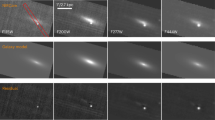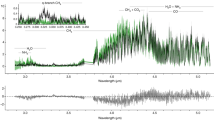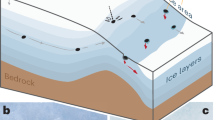Abstract
Comets are known to harbour simple ices and the organic precursors of the building blocks of proteins—amino acids—that are essential to life. Indeed, glycine, the simplest amino acid, was recently confirmed to be present on comet 81P/Wild-2 from samples returned by NASA’s Stardust spacecraft. Impacts of icy bodies (such as comets) onto rocky surfaces, and, equally, impacts of rocky bodies onto icy surfaces (such as the jovian and saturnian satellites), could have been responsible for the manufacture of these complex organic molecules through a process of shock synthesis. Here we present laboratory experiments in which we shocked ice mixtures analogous to those found in a comet with a steel projectile fired at high velocities in a light gas gun to test whether amino acids could be produced. We found that the hypervelocity impact shock of a typical comet ice mixture produced several amino acids after hydrolysis. These include equal amounts of D- and L-alanine, and the non-protein amino acids α-aminoisobutyric acid and isovaline as well as their precursors. Our findings suggest a pathway for the synthetic production of the components of proteins within our Solar System, and thus a potential pathway towards life through icy impacts.
This is a preview of subscription content, access via your institution
Access options
Subscribe to this journal
Receive 12 print issues and online access
$259.00 per year
only $21.58 per issue
Buy this article
- Purchase on Springer Link
- Instant access to full article PDF
Prices may be subject to local taxes which are calculated during checkout



Similar content being viewed by others
References
Chyba, C. F., Thomas, P. J., Brookshaw, L. & Sagan, C. Cometary delivery of organic molecules to the early Earth. Science 249, 366–373 (1990).
Chyba, C. F. & Sagan, C. Endogenous production, exogenous delivery and impact-shock synthesis of organic molecules: An inventory for the origins of life. Nature 355, 125–132 (1992).
Anders, E. Prebiotic organic matter from comets and asteroids. Nature 342, 255–257 (1989).
Furukawa, Y., Sekine, T., Oba, M., Kakegawa, T. & Nakazawa, H. Biomolecule formation by oceanic impacts on early Earth. Nature Geosci. 2, 62–66 (2009).
Schidlowski, M. A 3,800-million year isotopic record of life from carbon in sedimentary rocks. Nature 333, 313–318 (1988).
Schopf, J. W. Microfossils of the early Archean apex chert: New evidence of the antiquity of life. Science 260, 640–646 (1993).
Moorbath, S. Palaeobiology: Dating earliest life. Nature 434, 155 (2005).
Bar-Nun, A., Bar-Nun, N., Bauer, S. H. & Sagan, C. Shock synthesis of amino acids in simulated primitive environments. Science 168, 470–473 (1970).
Bar-Nun, A. & Shaviv, A. Dynamics of the chemical evolution of earth’s primitive atmosphere. Icarus 24, 197–210 (1975).
Goldman, N., Reed, E. J., Fried, L. E., William Kuo, I-F. & Maiti, A. Synthesis of glycine-containing complexes in impacts of comets on early Earth. Nature Chem. 2, 949–954 (2010).
Festou, M., Uwe-Keller, H. & Weaver, H. A. Comets-II (Univ. Arizona Press, 2005).
DiSanti, M. A., Bonev, B. P., Villanueva, G. L. & Mumma, M. J. Highly depleted ethane and mildly depleted methanol in Comet 21P/Giacobini-Zinner: Application of a new empirical υ2-band model for CH3OH near 50 K. Astrophys. J. 763, 1–15 (2013).
Crovisier, J. & Bockelée-Morvan, D. Remote observations of the composition of cometary volatiles. Space Sci. Rev. 90, 19–32 (1999).
Ehrenfreund, P. et al. Astrophysical and astrochemical insights into the origin of life. Rep. Prog. Phys. 65, 1427–1487 (2002).
Ehrenfreund, P. & Charnley, S. B. Organic molecules in the interstellar medium, comets, and meteorites: A voyage from dark clouds to the early Earth. Annu. Rev. Astron. Astrophys. 38, 427–483 (2000).
Mumma, M. J. et al. Remote infrared observations of parent volatiles in comets: A window on the early solar system. Adv. Space Res. 31, 2563–2575 (2003).
Bockelée-Morvan, D. et al. New molecules found in cometC/1995 O1 (Hale–Bopp). Investigating the link between cometary and interstellar material. Astron. Astrophys. 353, 1101–1114 (2000).
Elsila, J. E., Glavin, D. P. & Dworkin, J. P. Cometary glycine detected in samples returned by Stardust. Meteorit. Planet. Sci. 44, 1323–1330 (2009).
Blank, J. G., Miller, G. H., Ahrens, M. J. & Winans, R. E. Experimental shock chemistry of aqueous amino acid solutions and the cometary delivery of prebiotic compounds. Orig. Life Evol. B 31, 15–51 (2001).
Pierazzo, E., Kring, D. A. & Melosh, H. J. Hydrocode simulation of the Chicxulub impact event and the production of climatically active gases. J. Geophys. Res. 103, 28607–28625 (1998).
Pierazzo, E. & Chyba, C. F. Amino acid survival in large cometary impacts. Meteorit. Planet. Sci. 34, 909–918 (1999).
Pierazzo, E. & Chyba, C. F. in Comets and the Origins and Evolution of Life II (eds Thomas, P. J., Hicks, R., Chyba, C. F. & McKay, C. P.) 137–168 (Springer, 2006).
Blank, J. G. & Miller, G. H. in Proc. 21st Int. Symp. on Shock Waves (eds Houwing, A. F. P. et al.) 1467–1472 (Panther Press, 1998).
Burchell, M. J., Cole, M. J., McDonnell, J. A. M. & Zarnecki, J. C. Hypervelocity impact studies using the 2 MV Van de Graaff accelerator and two-stage light gas gun of the University of Kent at Canterbury. Meas. Sci. Technol. 10, 41–50 (1999).
Waite, J. H. et al. Liquid water on Enceladus from observations of ammonia and 40Ar in the plume. Nature 460, 487–490 (2009).
Brown, R. H. et al. Composition and physical properties of Enceladus’ surface. Science 311, 1425–1428 (2006).
Clark, R. N. et al. Detection and mapping of hydrocarbon deposits on titan. J. Geophys. Res. 115, E10 (2010).
Merlin, F., Quirico, E., Barucci, M. A. & de Bergh, C. Methanol ice on the surface of minor bodies in the solar system. Astron. Astrophys. 544, A20 (2012).
Shin, B. et al. Methanol incorporation in clathrate hydrates and the implications for oil and gas pipeline flow assurance and icy planetary bodies. Proc. Natl Acad. Sci. USA 110, 8437–8442 (2013).
Kvenvolden, K. et al. Evidence for extraterrestrial amino-acids and hydrocarbons in the Murchison meteorite. Nature 228, 923–926 (1970).
Silfer, J. A., Engel, M. H., Macko, S. A. & Jumeau, E. J. Stable carbon isotope analysis of amino acid enantiomers by conventional isotope ratio mass spectrometry and combined gas chromatography/isotope ratio mass spectrometry. Anal. Chem. 63, 370–374 (1991).
Macko, S. A., Uhle, M. E., Engel, M. H. & Andrusevich, V. Stable nitrogen isotope analysis of amino acid enantiomers by gas chromatography combustion-isotope ratio mass spectrometry. Anal. Chem. 69, 926–929 (1997).
Martins, Z., Alexander, C. M. O’D., Orzechowska, G. E., Fogel, M. L. & Ehrenfreund, P. Indigenous amino acids in primitive CR meteorites. Meteorit. Planet. Sci. 42, 2125–2136 (2007).
Bonner, W. A. The origin and amplification of biomolecular chirality. Orig. Life Evol. Biosphere 21, 59–111 (1991).
Sephton, M. A. Organic compounds in carbonaceous meteorites. Nat. Product Rep. 19, 292–311 (2002).
Cronin, J. R. & Chang, S. in The Chemistry of Life’s Origin (eds Greenberg, J. M., Mendoza-Gomez, C. X. & Pirronello, V.) 209–258 (Kluwer, 1993).
Peltzer, E. T., Bada, J. L., Schlesinger, G & Miller, S. L. The chemical conditions on the parent body of the Murchison meteorite: Some conclusions based on amino, hydroxy, and dicarboxylic acids. Adv. Space Res. 4, 69–74 (1984).
Lerner, N. R., Peterson, E. & Chang, S. The Strecker synthesis as a source of amino acids in carbonaceous chondrites—deuterium retention during synthesis. Geochim. Cosmochim. Acta 57, 4713–4723 (1993).
Price, M. C., Burchell, M. J., Kearsley, A. T. & Cole, M. J. 43rd Lunar and Planetary Science Conf., Abstr. 1755 (2012).
Henkel, T. et al. 43rd Lunar and Planetary Science Conf. Abstr. 2158 (2012).
Parnell, J. et al. The preservation of fossil biomarkers during meteorite impact events: Experimental evidence from biomarker-rich projectiles and target rocks. Meteorit. Planet. Sci. 48, 1340–1358 (2010).
Ostro, S. J. et al. Cassini RADAR observations of Enceladus, Tethys, Dione, Rhea, Iapetus, Hyperion, and Phoebe. Icarus 183, 479–490 (2006).
Thiemann, W. H. P. & Meierhenrich, U. ESA mission ROSETTA will probe for chirality of cometary amino acids. Orig. Life Evol. Biol. 31, 199–200 (2001).
Hartogh, P. et al. Ocean-like water in the Jupiter-family comet 103P/Hartley 2. Nature 478, 218–220 (2011).
Pizzarello, S., Williams, L. B., Lehman, J., Holland, G. P. & Yarger, J. L. Abundant ammonia in primitive asteroids and the case for a possible exobiology. Proc. Natl Acad. Sci. USA 108, 4303–4306 (2011).
The announcement of JUICE as the next L-class ESA mission was made on the 5th May 2012. Available at http://sci.esa.int/science-e/www/object/index.cfm?fobjectid=50400 (accessed 1st June 2012).
Berstein, M. et al. Racemic amino acids from the ultraviolet photolysis of interstellar ice analogues. Nature 416, 401–403 (2002).
Muñoz Caro, G. M. et al. Amino acids from ultraviolet irradiation of interstellar ice analogues. Nature 416, 403–406 (2002).
Meinert, C., Filippi, J. J., de Marcellus, P., Le Sergeant d’Hendecourt, L. & Meierhenrich, U. J. N-(2-Aminoethyl)glycine and amino acids from interstellar ice analogues. ChemPhysChem 77, 186–191 (2012).
Acknowledgements
We acknowledge financial support from the Science and Technology Facilities Council (STFC). Z. Martins is financially supported by the Royal Society. Many thanks to M. Cole for his technical expertise and for firing the gun, and A. Kearsley and P. Wozniakiewicz for many useful and inspiring discussions.
Author information
Authors and Affiliations
Contributions
M.C.P. made the ice targets and performed the hypervelocity impact-shock experiments. Z.M. performed the amino acid analysis and interpretation. N.G. performed the hydrodynamic simulations of cometary impacts. M.C.P., N.G. and M.J.B. designed the experimental impact study. Z.M. and M.C.P. wrote the article and contributed equally to the study. M.J.B. and M.A.S. provided experimental facilities. All of the authors discussed the results and commented on the manuscript.
Corresponding authors
Ethics declarations
Competing interests
The authors declare no competing financial interests.
Supplementary information
Supplementary Information
Supplementary Information (PDF 1405 kb)
Rights and permissions
About this article
Cite this article
Martins, Z., Price, M., Goldman, N. et al. Shock synthesis of amino acids from impacting cometary and icy planet surface analogues. Nature Geosci 6, 1045–1049 (2013). https://doi.org/10.1038/ngeo1930
Received:
Accepted:
Published:
Issue Date:
DOI: https://doi.org/10.1038/ngeo1930
This article is cited by
-
Extraterrestrial Impacts Creating Architectures for Life
Journal of the Indian Institute of Science (2023)
-
Glycine amino acid transformation under impacts by small solar system bodies, simulated via high-pressure torsion method
Scientific Reports (2022)
-
Prebiotic Syntheses Under Shock in the Water – Formamide – Potassium Bicarbonate – Sodium Hydroxide System
Origins of Life and Evolution of Biospheres (2019)
-
Synthesis of TiCx Powder via the Underwater Explosion of an Explosive
Metals and Materials International (2018)
-
Astrobiology and the Possibility of Life on Earth and Elsewhere…
Space Science Reviews (2017)



